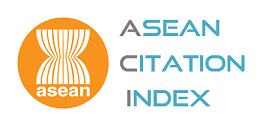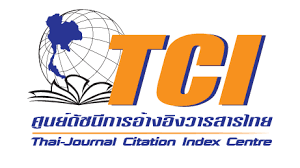Structural tuning of BiOI toward Bi\(_{2}\)O\(_{3}\)/AgI heterostructures via room-temperature ion exchange for improved photocatalytic activity
DOI:
https://doi.org/10.55713/jmmm.v35i4.2402Keywords:
BiOI-derived materials, Ion exchange synthesis, Heterojunction photocatalyst, Visible-light photodegradation, Indigo carmineAbstract
In this work, a bismuth oxide/silver iodide (Bi2O3/AgI) heterojunction photocatalyst was successfully fabricated via a room-temperature ion exchange process using bismuth oxyiodide (BiOI) as a morphology-directing precursor. Building upon our previous work on solvent-modulated BiOI nanostructures, this study employs a chemical transformation route to develop interfacially connected heterostructures while preserving key morphological features. Structural, morphological, and optical characterizations, including X-ray diffraction, field-emission scanning electron microscopy, energy-dispersive X-ray spectroscopy, Fourier-transform infrared spectroscopy, and ultraviolet–visible diffuse reflectance spectroscopy, provided supporting evidence for the successful formation of Bi2O3/AgI heterojunctions with likely close interfacial contact. The optimized Bi2O3/AgI composite with a 50:50 mass ratio demonstrated the highest photocatalytic activity, enabling nearly complete degradation of indigo carmine within 30 minutes under visible-light irradiation, clearly outperforming both pristine Bi2O3 and AgI. The enhanced performance is attributed to efficient charge carrier separation and improved visible-light absorption enabled by favorable band alignment. These findings highlight the potential of BiOI-based ion-exchange strategies for designing efficient and scalable photocatalysts for environmental remediation.
Downloads
References
S. Kato, and Y. Kansha, “Comprehensive review of industrial wastewater treatment techniques,” Environmental Science and Pollution Research, vol. 31, pp. 51064–51067, 2024. DOI: https://doi.org/10.1007/s11356-024-34584-0
S. Thueanbangyang, K. Singsumphan, V. Atimayulerd, C. Nakmuk, C. Suwanchawalit, and M. Aiempanakit, “Synthesis temperature-driven enhancements in BiOI photocatalysis: A hydrothermal approach, ” Journal of Metals, Materials and Minerals, vol. 35, no. 3, p. e2318, 2025. DOI: https://doi.org/10.55713/jmmm.v35i3.2318
D. Daskalova, G. A. Flores, U. Plachetka, M. Möller, J. Wolters, T. Wintgens, and M. C. Lemme, “Combined structural and plasmonic enhancement of nanometer-thin film photocatalysis for solar-driven wastewater treatment,” ACS Applied Nano Materials, vol. 6, pp. 15204–15212, 2023. DOI: https://doi.org/10.1021/acsanm.3c02867
F. K. Algethami, M. R. Elamina, and B. Y. Abdulkhair, “Simple preparation of a sunshine -like bismuth oxyiodide nanosheets for photocatalytic degradation of organic pollutant under sunlight,” Journal of Optoelectronic and Biomedical Materials, vol. 1, pp. 57–65, 2021. DOI: https://doi.org/10.15251/JOBM.2021.132.57
L. Huidobro, A. Domingo, E. Gomez, and A. Serra, “Bismuth oxyiodide-based composites for advanced visible-light activation of peroxymonosulfate in pharmaceutical mineralization,” Chemosphere, vol. 366, p. 143532, 2024. DOI: https://doi.org/10.1016/j.chemosphere.2024.143532
J.-W. Zhao, Z.-Q. Wei, S.-P. Huang, L. Li, and J.-H. Ma, “Photocatalytic properties of bismuth oxyiodide nanomaterials with different morphologies,” Desalination and Water Treatment, vol. 281, pp. 287–295, 2023. DOI: https://doi.org/10.5004/dwt.2023.29150
M. R. Elamin, K. H. Ibnaouf, N. Y. Elamin, F. A. Adam, A. H. Alolayan, and B. Y. Abdulkhair, “Spontaneous adsorption and efficient photodegradation of indigo carmine under visible light by bismuth oxyiodide nanoparticles fabricated entirely at room temperature,” Inorganics, vol. 10, no. 5, p. 65, 2022. DOI: https://doi.org/10.3390/inorganics10050065
J. Luo, X. Zhou, L. Ma, and X. Xu, “Enhanced visible-light-driven photocatalytic activity of WO3/BiOI heterojunction photocatalysts,” Journal of Molecular Catalysis A: Chemical, vol. 410, pp. 168–176, 2015. DOI: https://doi.org/10.1016/j.molcata.2015.09.019
Y. Guan, J. Wu, Xi. Man, Q. Liu, Y. Qi, P. He, and X. Qi, “Rational fabrication of flower-like BiOI1-x photocatalyst by modulating efficient iodine vacancies for mercury removal and DFT study,” Chemical Engineering Journal, vol. 396, p. 125234, 202010. DOI: https://doi.org/10.1016/j.cej.2020.125234
K. Ren, K. Zhang, J. Liu, H. Luo, Y. Huang, and X. Yu, “Controllable synthesis of hollow/flower-like BiOI microspheres and highly efficient adsorption and photocatalytic activity,” Crystal Engineering Communications, vol. 14, pp. 4384–4390, 2012. DOI: https://doi.org/10.1039/c2ce25087j
Y. Bu, J .Xu, Y. Li, Q. Liu, and X. Zhang, “Enhanced photocatalytic activity of BiOI under visible light irradiation by the modification of MoS2,” Royal Society of Chemistry, vol. 7, pp. 42398–42406, 2017. DOI: https://doi.org/10.1039/C7RA06462D
J. Jiang, Z. Mu, P. Zhao, H. Wang, and Y. Lin, “Photo-generated charge behavior of BiOI/g-C3N4 photocatalyst in photoreduction of Cr(VI): A novel understanding for high-performance,” Materials Chemistry and Physics, vol. 252, p. 123194, 2020. DOI: https://doi.org/10.1016/j.matchemphys.2020.123194
T. Zhang, Z.-C. He, Q. Mei, W. Peng, Q.-Z. Wang, H.-F. Cheng, and F. Ding, “Monolayer BiOI doped with nonmetals (B, C, N, Si, P, S) to enhance photocatalytic hydrogen precipitation performance,” Applied Surface Science, vol. 669, p. 160560, 2024. DOI: https://doi.org/10.1016/j.apsusc.2024.160560
H. Wang, Y. Liang, L. Liu, J. Hu, P. Wu, and W. Cui, “Enriched photoelectrocatalytic degradation and photoelectric performance of BiOI photoelectrode by coupling rGO,” Applied Catalysis B: Environmental, vol. 208, pp. 22–34, 2017. DOI: https://doi.org/10.1016/j.apcatb.2017.02.055
S. Luo, C. Tang, Z. Huang, C. Liu, J. Chen, and M. Fang, “Effect of different Bi/Ti molar ratios on visible-light photocatalytic activity of BiOI/TiO2 heterostructured nanofibers,” Ceramics International, vol. 42, pp. 15780–15786, 2016. DOI: https://doi.org/10.1016/j.ceramint.2016.07.043
Z. Liu, X. Xu, J. Fang, X. Zhu, J. Chu, and B. Li, “Micro-emulsion synthesis, characterization of bismuth oxyiodine/ titanium dioxide hybrid nanoparticles with outstanding photo-catalytic performance under visible light irradiation,” Applied Surface Science, vol. 258, pp. 3771– 3778, 2012. DOI: https://doi.org/10.1016/j.apsusc.2011.12.025
L. Hu, Y. Liao, D. Xia, Q. Zhang, H. He, J. Yang, Y. Huang, H. Liu, F. Zhang, C. He, and D. Shu, “In-situ fabrication of AgI-BiOI nanoflake arrays film photoelectrode for efficient wastewater treatment, electricity production and enhanced recovery of copper in photocatalytic fuel cell,” Catalysis Today, vol. 339, pp. 379–390, 2020. DOI: https://doi.org/10.1016/j.cattod.2018.12.026
J. Lv, Q. Hu, C. Cao, and Y. Zhao, “Modulation of valence band maximum edge and photocatalytic activity of BiOX by incorporation of halides,” Chemosphere, vol. 191, pp. 427–437, 2018. DOI: https://doi.org/10.1016/j.chemosphere.2017.09.149
J. Cao, Y. Zhao, H. Lin, B. Xu, and S. Chen, “Facile synthesis of novel Ag/AgI/BiOI composites with highly enhanced visible light photocatalytic performances,” Journal of Solid State Chemistry, vol. 206, pp. 38–44, 2013. DOI: https://doi.org/10.1016/j.jssc.2013.07.028
Q. Wang, X. Shi, E. Liua, J. C. Crittenden, X. Ma, Y. Zhanga, and Y. Cong, “Facile synthesis of AgI/BiOI-Bi2O3 multi-hetero-junctions with high visible light activity for Cr(VI) reduction, ” Journal of Hazardous Materials, vol. 317, pp. 8–16, 2016. DOI: https://doi.org/10.1016/j.jhazmat.2016.05.044
K. A. Reyna-Cavazos, A. Martínez-de la Cruz, D. Contreras, and F. E. Longoria-Rodríguez, “Polyol-assisted coprecipitation synthesis of BiOI photocatalyst and its activity to remove NOx, ” Research on Chemical Intermediates, vol. 48, pp. 949–967, 2022. DOI: https://doi.org/10.1007/s11164-022-04662-4
X. Xie, S. Wang, Y. Zhang, J. Ding, Y. Liu, Q. Yan, S. Lu, B. Li, Y. Liu, and Q. Cai, “Facile construction for new core-shell Z-scheme photocatalyst GO/AgI/Bi2O3 with enhanced visible-light photocatalytic activity,” Journal of Colloid and Interface Science, vol. 581, pp. 148–158, 2021. DOI: https://doi.org/10.1016/j.jcis.2020.07.128
Q. Yan, X. Xie, Y. Liu, S. Wang, M. Zhang, Y. Chen, and Y. Si, “Constructing a new Z-scheme multi-heterojunction photo-cataslyts Ag-AgI/ BiOI-Bi2O3 with enhanced photocatalytic activity,” Journal of Hazardous Materials, vol. 371, pp. 304–315, 2019. DOI: https://doi.org/10.1016/j.jhazmat.2019.03.031
V. Atimayulerd, S. Thueanbangyang, C. Nakmuk, K. Singsumphan, K. Aiempanakit, K. Charoenkitamorn, C. Suwanchawalit, and M. Aiempanakit, “Enhanced visible-light photocatalytic activity of BiOI synthesized via simple solvent engineering,” Optik, vol. 338, p. 172502, 2025. DOI: https://doi.org/10.1016/j.ijleo.2025.172502
M. Aiempanakit, P. Sudjai, K. Singsumphan, S. Laksee, and C. Suwanchawalit, “Brazilein modified zinc oxide nanorods with enchanced visible light-responsive photocatalytic efficiency,” Journal of Metals, Materials and Minerals, vol. 32, no. 2, pp. 70-76, 2022. DOI: https://doi.org/10.55713/jmmm.v32i2.1255
K. Singsumphan, C. Suwanchawalit, W. Somsorod, T. Sripathomkul, P. Sawanglap, K. Aiempanakit, and M. Aiempanakit, “Low-voltage electrophoretic deposition of silver nanoparticles on ZnO nanorods thin films for enhanced visible-light photocatalysis,” Optik, vol. 322, pp. 172179, 2025. DOI: https://doi.org/10.1016/j.ijleo.2024.172179
A. Chuenkruit, W. Thongjoon, K. Aiempanakit, M. Aiempanakit, and C. Aiempanakit, “Nanostructure of TiO2 and WO3 multilayer films deposited on ITO glass for electrochromic enhanced photocatalytic activity,” Journal of Metals, Materials and Minerals, vol. 34, no. 4, pp. 1964, 2024. DOI: https://doi.org/10.55713/jmmm.v34i4.1964
M. Aiempanakit, J. Sangkaworn, N. Worawannotai, K. Laohhasurayotin, W. Sangchay, S. Lakseee, and C. Suwanchawalit, “Enhancement of visible light-responsive photocatalytic efficiency by using a laccaic acid-modified titanium dioxide photocatalyst,” Journal of the Brazilian Chemical Society, vol. 33, no. 6, pp. 541-549, 2022. DOI: https://doi.org/10.21577/0103-5053.20220006
D. A. Reddy, J. Choi, S. Lee, R. Ma, and T. K. Kim, “Green synthesis of AgI nanoparticle-functionalized reduced graphene oxide aerogels with enhanced catalytic performance and facile recycling,” Royal Society of Chemistry, vol. 5, pp. 67394-67404, 2015. DOI: https://doi.org/10.1039/C5RA07267K
Y. Xu, S. Huang, H. Ji, L. Jing, M. He, H. Xu, Q. Zhan, and H. Li, “Facile synthesis of CNT/AgI with enhanced photo-catalytic degradation and antibacterial ability,” Royal Society of Chemistry, vol. 6, p. 6905, 2016. DOI: https://doi.org/10.1039/C5RA24620B
M. Arumugam, K.-K. Seralathan, S. Praserthdam, M. Tahir, and P. Praserthdam, “Synthesis of novel graphene aerogel encapsulated bismuth oxyiodide composite towards effective removal of methyl orange azo-dye under visible light,” Chemosphere, vol. 303, pp. 135121, 2022. DOI: https://doi.org/10.1016/j.chemosphere.2022.135121
T. Selvamani, S. Anandan, L. Granone, D. W. Bahnemann, and M. Ashokkumar, “Phase-controlled synthesis of bismuth oxide polymorphs for photocatalytic applications,” Materials Chemistry Frontiers, vol. 2, no. 9, pp. 1664-1673, 2018. DOI: https://doi.org/10.1039/C8QM00221E
X. Wang, X. Wan, W. Li, and X. Chen, “One-step hydro-thermal synthesis of the Ag/AgI heterojunction with highly enhancedvisible-light photocatalytic performances,” Micro & Nano Letters, vol. 9, no. 6, p. 376–381, 2014. DOI: https://doi.org/10.1049/mnl.2014.0099
Y. Sun, W.Wang, L. Zhang, and Z. Zhang, “Design and controllable synthesis of a-/γ-Bi2O3 homojunction with synergetic effect on photocatalytic activity,” Chemical Engineering Journal, vol. 211-212, pp. 161-167, 2012. DOI: https://doi.org/10.1016/j.cej.2012.09.084
L. Yosefi, and M. Haghighi, “Fabrication of nanostructured flowerlike p-BiOI/p-NiO Heterostructure and its efficient photo-
catalytic performance in water treatment under visible-light irradiation,” Applied Catalysis B: Environmental, vol. 220, pp. 367-378, 2018. DOI: https://doi.org/10.1016/j.apcatb.2017.08.028
J. Henle, P. Simon, A. Frenzel, S. Scholz, and S. Kaskel, “Nanosized BiOX (X) Cl, Br, I) Particles synthesized in reverse microemulsions,” Chemistry of Materials, vol. 19, no. 3, pp. 366-373, 2007. DOI: https://doi.org/10.1021/cm061671k
O. Husberg, H. Vogelsang, and W. von der Osten, “Confined excitons in AgI nanocrystals in crystalline KI matrix,” Journal of Luminescence, vol. 96, pp. 155–162, 2002. DOI: https://doi.org/10.1016/S0022-2313(01)00232-0
Q. Yang, J. Huang, J. Zhong, J. Chen, J. Li, and S. Sun, “Charge separation behaviors of novel AgI/BiOI heterostructures with enhanced solar-photocatalytic performance,” Current Applied Physics, vol. 17, pp. 1202-1207, 2017. DOI: https://doi.org/10.1016/j.cap.2017.05.016
X. Jia, H. Lin, J. Cao, C. Hu, H. Sun, and S. Chen, “Synergistic introduction of oxygen vacancy and silver/silver iodide: Realizing deep structure regulation on bismuth oxybromide for robust carbon dioxide reduction and pollutant oxidation,” Journal of Colloid and Interface Science, vol. 624, pp. 181-195, 2022. DOI: https://doi.org/10.1016/j.jcis.2022.05.101
V. Ruiz-Santoyo, S. García-Carvajal, and M. C. Arenas-Arrocena, “Photocatalytic removal of synthetic dyes using Bi2O3–TiO2 nanocomposites obtained by simple hydrothermal route,” Journal of Nanoparticle Research, vol. 27, 2025. DOI: https://doi.org/10.1007/s11051-024-06207-9
S. Madji, M. Belmedani, E. Mekatel, S. Zouaoui, and S. E. I. Lebouachera, “The development of a new Bi12ZnO20/AgI heterosystem for the degradation of dye-contaminated water by photocatalysis under solar irradiation: Synthesis, characterization and kinetics,” Processes, vol. 13, pp. 1342, 2025. DOI: https://doi.org/10.3390/pr13051342
M. Mousavi-Kamazani, M. Ghodrati, and R. Rahmatolahzadeh, “Fabrication of Z-scheme flower-like AgI/Bi2O3 heterojunctions with enhanced visible light photocatalytic desulfurization under mild conditions.” Journal of Materials Science: Materials in Electronics, vol. 31, pp. 5622-5634, 2020. DOI: https://doi.org/10.1007/s10854-020-03129-9
Z. Chuan, H. Yifen, S. Jingtao, H. Shaohua, M. Minfeng, Z. Liang, L. Kaiwen, and G. Yingying, “Enhanced photocatalytic degradation of indigo carmine dye by biomass carbon supported beta-Bi2O3 doping with Ag ions.” Journal of Alloys and Compounds, vol. 1024, pp. 180163, 2025. DOI: https://doi.org/10.1016/j.jallcom.2025.180163
M. Vautier, C. Guillard, and J.-M. Herrmann, “Photocatalytic degradation of dyes in water: Case study of indigo and of indigo carmine.” Journal of Catalysis, vol. 201, no. 1, pp. 46-59, 2001. DOI: https://doi.org/10.1006/jcat.2001.3232

Downloads
Published
How to Cite
License
Copyright (c) 2025 Journal of Metals, Materials and Minerals

This work is licensed under a Creative Commons Attribution-NonCommercial-NoDerivatives 4.0 International License.
Authors who publish in this journal agree to the following terms:
- Authors retain copyright and grant the journal right of first publication with the work simultaneously licensed under a Creative Commons Attribution License that allows others to share the work with an acknowledgment of the work's authorship and initial publication in this journal.
- Authors are able to enter into separate, additional contractual arrangements for the non-exclusive distribution of the journal's published version of the work (e.g., post it to an institutional repository or publish it in a book), with an acknowledgment of its initial publication in this journal.












